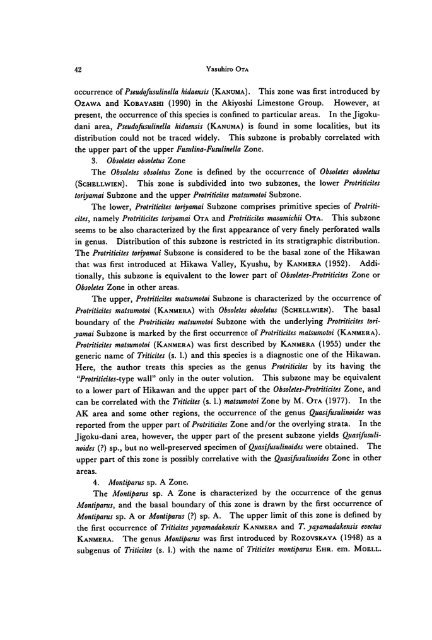Biostratigraphy of the Akiyoshi Limestone Group,
Biostratigraphy of the Akiyoshi Limestone Group,
Biostratigraphy of the Akiyoshi Limestone Group,
You also want an ePaper? Increase the reach of your titles
YUMPU automatically turns print PDFs into web optimized ePapers that Google loves.
42 Yasuhiro Ota<br />
occurrence <strong>of</strong> Pseud<strong>of</strong>usulinella hidaensis (Kanuma). This zone was first introduced by<br />
Ozawa and Kobayashi (1990) in <strong>the</strong> <strong>Akiyoshi</strong> <strong>Limestone</strong> <strong>Group</strong>. However, at<br />
present, <strong>the</strong> occurrence <strong>of</strong> this species is confined to particular areas. In <strong>the</strong> Jigokudani<br />
area, Pseud<strong>of</strong>usulinella hidaensis (Kanuma) is found in some localities, but its<br />
distribution could not be traced widely. This subzone is probably correlated with<br />
<strong>the</strong> upper part <strong>of</strong> <strong>the</strong> upper Fusulina-Fusulinella Zone.<br />
3. Obsoletes obsoletus Zone<br />
The Obsoletes obsoletus Zone is defined by <strong>the</strong> occurrence <strong>of</strong> Obsoletes obsoletus<br />
(Schellwien). This zone is subdivided into two subzones, <strong>the</strong> lower Protriticites<br />
toriyamai Subzone and <strong>the</strong> upper Protriticites matsumotoi Subzone.<br />
The lower, Protriticites toriyamai Subzone comprises primitive species <strong>of</strong> Protriti<br />
cites, namely Protriticites toriyamai Ota and Protriticites masamichii Ota. This subzone<br />
seems to be also characterized by <strong>the</strong> first appearance <strong>of</strong> very finely perforated walls<br />
in genus. Distribution <strong>of</strong> this subzone is restricted in its stratigraphic distribution.<br />
The Protriticites toriyamai Subzone is considered to be <strong>the</strong> basal zone <strong>of</strong> <strong>the</strong> Hikawan<br />
that was first introduced at Hikawa Valley, Kyushu, by Kanmera (1952). Addi<br />
tionally, this subzone is equivalent to <strong>the</strong> lower part <strong>of</strong> Obsoletes-Protriticites Zone or<br />
Obsoletes Zone in o<strong>the</strong>r areas.<br />
The upper, Protriticites matsumotoi Subzone is characterized by <strong>the</strong> occurrence <strong>of</strong><br />
Protriticites matsumotoi (Kanmera) with Obsoletes obsoletus (Schellwien). The basal<br />
boundary <strong>of</strong> <strong>the</strong> Protriticites matsumotoi Subzone with <strong>the</strong> underlying Protriticites tori<br />
yamai Subzone is marked by <strong>the</strong> first occurrence <strong>of</strong> Protriticites matsumotoi (Kanmera).<br />
Protriticites matsumotoi (Kanmera) was first described by Kanmera (1955) under <strong>the</strong><br />
generic name <strong>of</strong> Triticites (s. 1.) and this species is a diagnostic one <strong>of</strong> <strong>the</strong> Hikawan.<br />
Here, <strong>the</strong> author treats this species as <strong>the</strong> genus Protriticites by its having <strong>the</strong><br />
"Protriticites-tyot wall" only in <strong>the</strong> outer volution. This subzone may be equivalent<br />
to a lower part <strong>of</strong> Hikawan and <strong>the</strong> upper part <strong>of</strong> <strong>the</strong> Obsoletes-Protriticites Zone, and<br />
can be correlated with <strong>the</strong> Triticites (s. 1.) matsumotoi Zone by M. Ota (1977). In <strong>the</strong><br />
AK area and some o<strong>the</strong>r regions, <strong>the</strong> occurrence <strong>of</strong> <strong>the</strong> genus Quasifusulinoides was<br />
reported from <strong>the</strong> upper part <strong>of</strong>Protriticites Zone and/or <strong>the</strong> overlying strata. In <strong>the</strong><br />
Jigoku-dani area, however, <strong>the</strong> upper part <strong>of</strong> <strong>the</strong> present subzone yields Quasifusuli<br />
noides () sp., but no well-preserved specimen <strong>of</strong> Quasifusulinoides were obtained. The<br />
upper part <strong>of</strong>this zone is possibly correlative with <strong>the</strong> Quasifusulinoides Zone in o<strong>the</strong>r<br />
areas.<br />
4. Montiparus sp. A Zone.<br />
The Montiparus sp. A Zone is characterized by <strong>the</strong> occurrence <strong>of</strong> <strong>the</strong> genus<br />
Montiparus, and <strong>the</strong> basal boundary <strong>of</strong> this zone is drawn by <strong>the</strong> first occurrence <strong>of</strong><br />
Montiparus sp. A or Montiparus () sp. A. The upper limit <strong>of</strong> this zone is defined by<br />
<strong>the</strong> first occurrence <strong>of</strong> Triticites yayamadakensis Kanmera and T.yayamadakensis evectus<br />
Kanmera. The genus Montiparus was first introduced by Rozovskaya (1948) as a<br />
subgenus <strong>of</strong> Triticites (s. 1.) with <strong>the</strong> name <strong>of</strong> Triticites montiparus Ehr. em. Moell.
















